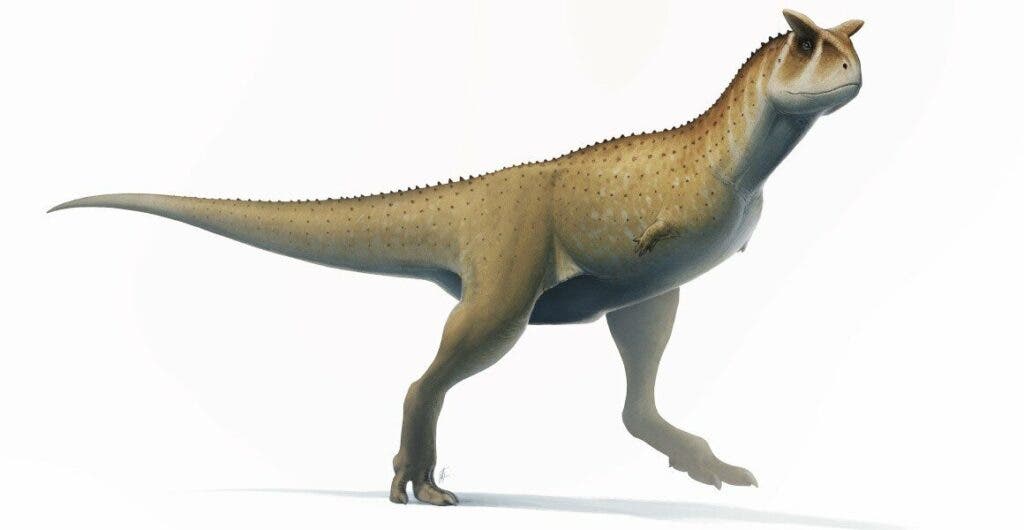Researchers in Argentina have uncovered a new species of dinosaur, Guemesia ochoai. It’s got almost no arms, a small head, and it’s not what you’d expect to find in the Late Cretaceous. This small, hornless predator represents the first definitive abelisaurid discovered in northwestern Argentina.
The fossil, a nearly complete braincase, was unearthed from the Los Blanquitos Formation in the Amblayo Valley, Salta province. Dated to 70 million years ago, it provides a rare glimpse into the unique ecosystems of the region during the Cretaceous. While most such fossils have been found in Patagonia, this discovery highlights the untapped potential of less-explored regions.

Abelisaurids were a group of theropod dinosaurs that lived during the Jurassic and Cretaceous periods. They were bipedal predators and have distinctive physical traits, including short, robust skulls with thick bone ornamentation, and tiny, virtually useless forelimbs. However, they were still top predators in their ecosystems, they preyed on a variety of animals, including sauropods.
But this newly discovered species is a curious one.
Unlike its relatives, Guemesia ochoai lacks the prominent skull projections or horns typical of abelisaurids. Its braincase is remarkably small—70% smaller than other species in its clade. This hints at the fossil being either a juvenile or having unique evolutionary traits. The presence of small foramina (holes) in the skull may have helped the animal regulate body temperature by releasing heat.
Paleontologists discovered the fossilized skull in Argentina. Because the dinosaur is so unusual, it could be that this part of Argentina had a rare type of ecosystem during the Late Cretaceous. The discovery is quite exciting for another reason. Researchers have found few abelisaurid fossils in the area so this fills in an important piece of its historical puzzle.
Armless in Argentina
“This new dinosaur is quite unusual for its kind. It has several key characteristics that suggest that is a new species, providing important new information about an area of the world which we don’t know a lot about,” says Professor Anjali Goswami, co-author of the study describing the species and a Research Leader at the Natural History Museum of London.
“It shows that the dinosaurs that live in this region were quite different from those in other parts of Argentina, supporting the idea of distinct provinces in the Cretaceous of South America. It also shows us that there is lot more to be discovered in these areas that get less attention than some of the more famous fossil sites.”
By the time this species emerged, the ancient supercontinent of Pangaea had already begun to break apart forming Gondwana and Laurasia. The former would, in turn, split into the major continents in the Southern Hemisphere today and India.
Even as these landmasses started slowly drifting apart, species could still move between them. Therefore, researchers assume that the fauna of these landmasses remained quite similar, as animals migrated between them. Abelisaurids were among these species.
Abelisaurids were top predators in their ecosystems, preying even on the mighty Titanosaurus, another predator. One of their most defining features was the front limbs; even shorter than those of the T. rex, these were virtually useless. In other words, the species did their hunting without being able to grasp, relying instead on their powerful jaws and necks to capture and subdue prey. They seem to have been quite successful at it, too. Fossils of these dinosaurs have been found in rocks all around the world, dating all the way to the extinction of the dinosaurs 66 million years ago.
Although Argentina is well-known for abelisaur fossils (35 species have been discovered here so far), the overwhelming majority of these were discovered in Patagonia, in the country’s south. The north-western stretches of the country have yielded precious few. The newly discovered skull joins this exclusive list.
A new member of an elite dinosaur club
The fossil was unearthed in the Los Blanquitos Formation near Amblayo, in the north of Argentina. It dates to between 75 and 65 million years ago. In other words, this specimen lived very close to the Cretaceous mass extinction, the event that wiped out the dinosaurs.
Like other abelisaurids, the skull contains a “remarkably small” braincase, according to its discoverers; its cranium is around 70% smaller than that of any of its relatives. This could suggest that the animal was a juvenile, but this is yet unconfirmed. One distinguishing feature of the dinosaur is a series of small holes at the front of its skull, arranged in rows, known as foramina. Researchers believe these holes helped the animal cool down, by allowing blood pumped into them (and covered by the thin skin at the front of the head) to release the heat it contained.
In contrast to other species of abelisaurids, the skull completely lacks any horns. This suggests that the species is among the first to emerge in the abelisaurid clade before these dinosaurs evolved horns.
Given that there is enough evidence to distinguish it as a new species, the team christened it after General Martin Miguel de Güemes, a hero of the Argentine War of Independence, and Javier Ochoa, a museum technician who discovered the specimen.
“Understanding huge global events like a mass extinction requires global datasets, but there are lots of parts of the world that have not been studied in detail, and tons of fossils remaining to be discovered,” Professor Anjali says.
“We left some exciting fossils in the ground on our last trip, not knowing that it would be years before we could get back to our field sites. Now we are hoping that it won’t be too much longer before we can finish digging them up and discovering many more species from this unique fauna.”
The paper “First definitive abelisaurid theropod from the Late Cretaceous of Northwestern Argentina” has been published in the Journal of Vertebrate Paleontology.
*This article was initially published in 2022 and has been reedited to include more information.


